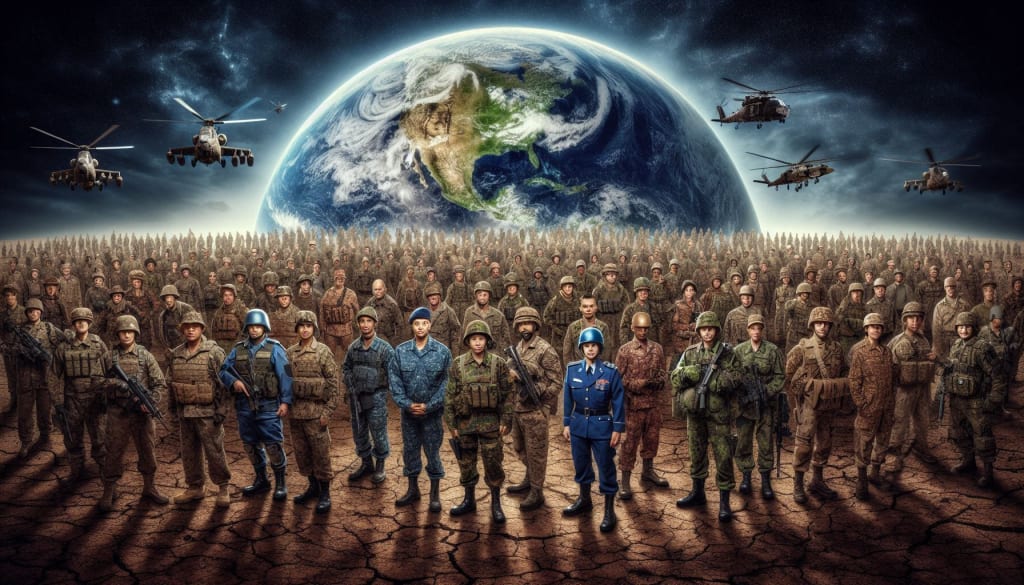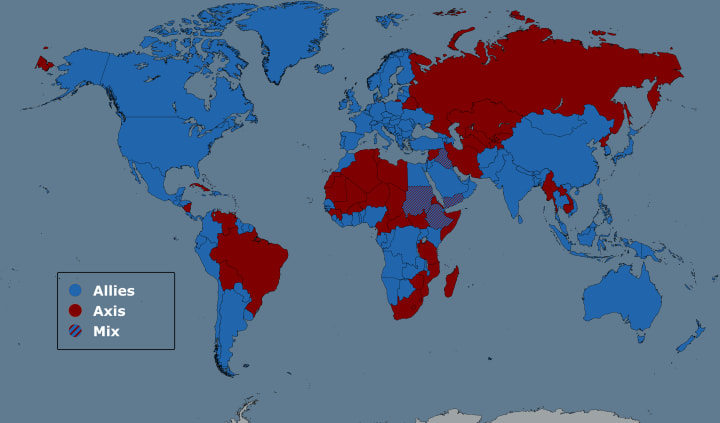
What I think is that if Russia had not invaded Ukraine, in all likelihood Hamas would not have launched such an attack on Israel. It was inevitable that such a serious violation of the international system based on law, at the hands of a permanent member of the UN Security Council, had cascading consequences on other areas... of the world, from the Middle East to the Balkans, to Africa. This is the game we are playing, and we have to be aware. If international law is not re-established in Ukraine, the outbreaks of conflict will continue to multiply.
Prime Minister of Italy Giorgia Meloni on February 24, 2024 (via machine translation of https://www.ilgiornale.it/news/governo/ucraina-gaza-e-loccidente-mia-idea-pace-2288075.html)
No matter what specifically might end up being the final match that could set the Earth ablaze, the result would be the same: World War III. For this planet-wide conflict, there can be no staying on the sidelines, no fence-sitting, no neutrality, and no option to play both camps against each other for personal gain. Among the around two hundred individual nations and independently-acting paramilitary forces, they would need to align with one group or another. So, by how things were situated in the mid-2020s, where would all the chips fall? Who would unite with the Allies, and who would link up with the Axis?
Key Players
Beginning with the Axis, the core group led by Russia would consist of immediate partners North Korea, Syria, and Iran—including proxy terrorist organizations Hamas in Palestine, Hezbollah in Lebanon, the Houthis in Yemen, and various smaller militias in places like Iraq. As such, the Allies would begin with the nemeses of these nations: the United States of America, Ukraine, South Korea, and Israel. However, each of these countries would come with their own unique, and sometimes unexpected, supporters. For instance, although it may not be shocking that Belarus, Cuba, and Venezuela would join the Axis; some may be stunned to learn that South Africa and Brazil are far closer ideologically to Russia than they are to anywhere else, thus making them natural partners.
On the other end, an attack on the United States or any other member of NATO is also considered to be one against all of them. In a circumstance like this, the United Kingdom, Canada, Germany, France, Spain, Portugal, Italy, Poland, Finland, Sweden, Albania, Belgium, Bulgaria, Croatia, Czechia, Slovakia, Denmark, Estonia, Greece, North Macedonia, Iceland, Latvia, Lithuania, Luxembourg, Montenegro, the Netherlands, Romania, and Slovenia would be immediately drawn into the war. When push comes to shove, even Russian-apologists—with questionable track records themselves around democracy and human-rights—Hungary and Türkiye would stick with NATO and not abandon their obligations; leaving unaccounted only four countries that are in the European Union but are not members of NATO. That said, Austria, Ireland, Malta, and Cyprus would all also be quick to lend their support to the rest of the Allies.
Unlikely Partners
With Cyprus, though, it would be a difficult proposition to cooperate with everyone in the Alliance, an even greater challenge than trying to convince Hungary to completely turn their backs on Russia. Türkiye is literally occupying Northern Cyprus, thus the two adversaries are technically at war with each other. For them to join forces under the same banner is a tall order, but they would not remotely be the strangest foes to find themselves forced into being devoted bedfellows.
Among the big hitters, Pakistan and India have regular skirmishes due to both desiring to control the entirety of the Kashmir expanse; yet they are equally politically and militarily bent towards those nations already listed in the Allies. Despite the fact that India gets the majority of its oil from Russia, their concerns could be placated with being given access to the spoils of war. In other words, India does not actually care about Russia; they only care about what Russia can cheaply provide them. If someone else could give them what they need, all the better. Along with these two would also come their close neighbors and strategic partners Sri Lanka, Bangladesh, Bhutan, and Nepal.
Much the same could be said for all the nation-states that arose from the region formerly known as Yugoslavia. Some would automatically be a part of the Allies based solely upon their membership in NATO, but the rest had already aspired to enroll in the same international defense pact. As such, Bosnia-Herzegovina and independence-disputed Kosovo would have to put aside their issues with Serbia, Croatia, and the rest and take on rolls supporting each other throughout the greater worldwide contest.
In the same vein, bitter rivals Azerbaijan and Armenia would also both sit in the barracks with the Allies, especially after Russia failed to protect Armenia from an Azerbaijan invasion in the early 2020s, as they promised they would. Armenia had already been trending towards the west even though the latter had failed to acknowledge the genocide of their people at the hands of the Ottoman Empire during World War I in order to placate fellow Allied Power Türkiye. Although the acrimony would remain, Armenia could temporarily put aside their legitimate grievances for the higher purpose of resolving the global conflict.
This would analogously be the case for Lebanon, too. While it was still theoretically at war with Israel and hosted terrorist organization Hezbollah not only physically, but as a part of the government, Lebanon was very close to the United States, France, and others. If anything, Lebanon would devolve back into a civil war with the official government joining the Allies and Hezbollah being a part of the Axis. And although Hezbollah and their counterpart Hamas were Palestinian terrorist organizations, the Palestinian Authority itself would likewise be on the side of the Allies, their true sponsors and supporters.
The biggest surprise, though, would be Afghanistan. Despite being overrun by the Taliban during a hasty US withdrawal—completely negating over twenty years of war and occupation—the one country Afghanistan hated more than anywhere else was Russia. These feelings were left over from the brutal Soviet invasion that lasted throughout the late 1970s and the entire 1980s. As such, every member of the Allies that wasted decades investing in trying to prop up an Afghan democracy would have to look the other way and accept the help of people who did not believe that women should have any rights, freedoms, or equality. The Taliban would also revel at the very idea of being accepted as a legitimate government, one that must be engaged with directly.
Autocrats and Dictators
Not every country had such a tumultuous relationship with Russia and the other aforementioned leaders of the Axis. On the contrary, Russia had a very successful and cordial international outreach program, especially in Africa. More so, there were those under vicious military dictatorships or autocracies of various kinds that did not take too kindly to any western interference. That is not to say that the Allies would not contain their fair share of such counties—as just demonstrated in the prior section and will be seen again and again below—but that many others were much closer to the methodologies, approaches, and tolerances as decreed by Russia, Iran, and their cronies.
Through quasi-government mercenary contractors like the Wagner Group, Russia was embedded in the Central Africa Republic, Madagascar, Libya, Mozambique, Burkina Faso, Chad, Mali, and South Sudan. Thus, in order to remain in power, all those countries would quickly join the Axis. Interestingly, even though Sudan was run by a military dictatorship that overthrew the democratically elected government, it would be on the side of the Allies. This is because Russia was supporting a separate military group in Sudan trying to usurp sovereignty, meaning the leadership at the time would have no choice but to turn to the Allies to stay in charge.
Even without direct intervention, many other nations were also closer to Russia either because of earlier Soviet Union support, post-Cold War involvement, or a combination of both. Among this group would be Lesotho, Zimbabwe, Tanzania, Equatorial Guinea, Cameroon, Tunisia, and Guinea. Finally, even those without historical connections would want to be a part of the Axis because they were more aligned philosophically with it compared to the principal members of the Allies. Chief amidst that contingent would be recent convert Niger, along with frequent collaborators Algeria, Somalia, Burundi, and Eritrea. And although Ethiopia probably should go to the Axis, too, they would not be able to tolerate Eritrea being a partner, especially as the latter had been supporting separatists within Ethiopian territory. Therefore, Ethiopia would technically be a part of the Allies while really fighting a civil war against secessionists that would be supported by the Axis. This would be similar to Morocco—a stalwart member of the Allies—as the Axis would stand behind breakaway Western Sahara.
Outside of Africa, there were many countries that were run by juntas, had terrible human rights records, or just had a difficult history with the United States and other former colonial empires. America had certainly gotten involved in other countries' internal affairs in the past, even overthrowing democratically elected governments in order to install autocrats that were more friendly to their interests. This had created many erstwhile enemies that would be eager to join the Axis, including Myanmar, Laos, Cambodia, Bolivia, and Nicaragua. However, not every member of the Axis would necessarily be there by their own volition, but rather simply because they were either surrounded by those who were happy to be in the Axis or they were dependent upon those same nations for resources and protection. That is why Eswatini, Mauritania, and Trinidad and Tobago would find themselves reluctant devotees of the Axis.
That is not to say that everyone would be completely adverse to being in the Axis, just that they would rather have remained uninvolved. Since neutrality would not be an option, the vassal member states of the Collective Security Treaty Organization—Russia's answer to NATO—Kazakhstan, Kyrgyzstan, and Tajikistan would find themselves caught up in the conflict as Axis followers. Although not a signatory, former Soviet block member Turkmenistan would also get swept up into the war on the side of the Axis. That would only leave Uzbekistan, which would want to remain nonaligned but would discover it was impossible to do so when circumscribed by Axis countries. As a desperate act of self-preservation, Uzbekistan would have no choice but to consent to being in the Axis.
With Friends Like These...
While a large portion of the former USSR would recombine into a collective armed force, not every country would be so swept up. Georgia—buoyed by nearby Türkiye, Azerbaijan, and Armenia—would gladly take up arms for the Allies, especially since Russia was already occupying part of their territory. They would quickly be followed by the few remaining European countries that were not in the EU nor a member of NATO, yet still fit in perfectly with the Allies: Andorra, Liechtenstein, Moldova, Monaco, and San Marino. In that area, these pledges would give way to only Switzerland and the Vatican without a formal designation. Even though both would claim impartiality, the reality would be far from that. Switzerland had already broken their so-called neutrality many times in the past, including by adopting and enforcing sanctions against Russia starting in 2022. Although neither would provide troops, they would give their tacit support through every other means possible. For all intents and purposes, they would be members of the Allies.
Others would not have any issue lending their names and prowess to the Allies through whatever measures were available to them. This would include almost the entirety of the rest of Africa with Botswana, Djibouti, Ghana, Kenya, Liberia, Mauritius, Namibia, Rwanda, Senegal, Angola, Nigeria, Uganda, Gabon, Comoros, Mayotte, Seychelles, Réunion, Malawi, Zambia, the Democratic Republic of Congo, the Republic of Congo, São Tomé and Príncipe, Cabo Verde, Gambia, Benin, Côte d'Ivoire, Sierra Leone, and Guinea-Bissau leading the charge. Even Togo would end up with the Allies; not because they aligned with them ideologically, but for the simple fact that they would be enveloped by all those other nations and would not want to be fighting a one-nation war against all of them.
In the Americas, the story would be much the same. First of all, European countries like France, the UK, and the Netherlands hold many overseas territories in the Western Hemisphere. As such, those lands would defacto be a part of the Allies. However, aside from the few nations previously mentioned, no others would choose Russia and Iran over the United States, despite many having had a tumultuous relationship and history with the latter. Therefore, Greenland, Mexico, Panama, the Bahamas, Jamaica, Haiti, the Dominican Republic, Anguilla, St. Barthélemy, St. Kitts and Nevis, Antigua and Barbuda, Dominica, St. Lucia, St. Vincent and the Grenadines, Barbados, Belize, Guatemala, El Salvador, Honduras, Costa Rica, French Guiana, Suriname, Guyana, Columbia, Ecuador, Peru, Paraguay, and Argentina would fill out the rest of the New World team.
In the Middle East and North Africa, the "moderate" Arab and Islamic states were already intertwined with the key players in the Allies. Due to this, Egypt, Saudi Arabia, Jordan, Kuwait, Bahrain, Qatar, and the United Arab Emirates would not hesitate—once there was no option to stay on the sidelines—to be one with of the Allies, especially to counter Iran. Even Oman would be forced to break their official neutrality and join their compatriots in the Allies. The official governments of their next-door-neighbor Yemen and distant Iraq would also be a part of the Allies; nevertheless, as covered previously, these nations would most likely break down into or continue their civil wars with the Iran-backed terrorist forces that they were already contending with. On the other hand, the singular party that would actually remain outside the Allies and the Axis would be Daesh (Islamic State). There is no love lost between Daesh and pretty much every other country and organization on Earth, therefore the remnants of Daesh would just be a troublesome thorn for everyone.
Other Islamic-majority states in the Asia-Pacific vicinity would likewise be important affiliates of the Allies, notably Indonesia, Malaysia, and Brunei. They would hardly be alone as dependable major partners Japan, Australia, New Zealand, and the Philippines would be some of the first nations to join the Allies. Coming along with them would be various countries that were protectorates, in free association, or some other similar situation: New Caledonia, Papua New Guinea, the Solomon Islands, Vanuatu, Fiji, Tuvalu, Nauru, Micronesia, Palau, Kiribati, Samoa, Tonga, and Niue. Even predominately Catholic Timor-Leste would end up in the Allies despite the fact that they had a strained relationship with former Islamic occupier Indonesia. Back on the mainland, Thailand would be an easy pickup for the Allies. More relevant, though, Vietnam had been trending away from Russia and towards the United States for some time. By taking a look around them, Vietnam would see that almost all their neighbors had decided to stand with the Allies. As such, they, too, would prefer to be a part of the Allies rather than risk what might happen should they align with the Axis.
Elephant in the Room
Of course, there is one major country that has not been discussed thus far:
China
Before getting into them, it is important to note that there would be no doubt that Taiwan would be a part of the Allies. In a vacuum, this would seem to be a fact that would push China to join the Axis, to whom they were otherwise politically and socially alike. Further, China had immense preexisting conflicts with all the other Allies who have made claims for land and passage through the South China Sea. Nonetheless, it is important to remember that China did not actually care about the well-being of places like Russia or Iran; they only wanted to expand their sphere of influence and enrich themselves. With Mongolia to the north also joining the Allies, China would find itself surrounded on almost all sides by Allied Powers. Should they join the Axis, much of the actual fighting and warfare would, as a consequence, end up taking place within their territory. Meanwhile, there were already many different ethnic and political groups that wanted to detach from China's hegemony. Thus, should they join the Axis, they would be inviting a slew of uprisings that would be supported by the majority of the outside world.
As such, the pragmatic choice for China, then, would be to enlist in the Allies. China would also surely notice that every nuclear-armed nation save Russia, North Korea, and themselves were not in the Allies; and that would not be a risk worth assuming. Although China would perhaps be the very last nation to sign the dotted line, they would find themselves in a similar role as the one the USSR occupied during World War II. Nonetheless, unlike the USSR, making this choice would help China keep most of the combat out of their interior. On their western front, Kazakhstan, Kyrgyzstan, and Tajikistan would not be able to mount much of an offense and therefore they could easily be kept at bay. The same would be true in the south with Myanmar and Laos, as well as in the east with North Korea—which might want to avoid a direct assault anyway for their own long-term survival. And despite having Russia to the northeast, the area abutting China was part of the vast emptiness known as Siberia. Russia would have its hands full on the European front far to the west and most likely would not be able to mount any type of attack so distant from their core population center. Russia or one of the other nearby Axis members might be able to occasionally launch a rocket China's way, but those would be so infrequent that they would not be a major concern.
If anything, by joining the Allies, China might find themselves not doing much at all; and an outcome like that would be perfectly reasonable and acceptable to the rest of the Allies. As far as the Allies would be concerned, an uninvolved China would be much more preferable to one actively fighting for the Axis. Plus, at the end of the war, Russia would need to be occupied for a long time. Just as the USSR got to control vast swaths of Europe all the way through East Germany after World War II, China would be able to do the same with everything east of the Urals. While Siberia is often derided, it contains extensive mineral wealth and rich soil for growing crops. What would mollify China more than giving them complete dominion over all that?
Our World at War
In case it is not clear, the Axis would be in trouble. By a pure nation-state and paramilitary forces count, well over three and a half times more factions would be with the Allies. Based upon what has been listed above, it would be 156 Allied Powers to 43 Axis adherents. Still, in all fairness, the number of countries and supporting groups is only part of the equation. There is something to be said about quality over quantity.

By those measures, too, the Allies would hold a clear advantage. They would have the weaponry, the transport vessels, the access to natural resources, the population pool to pick from, the money, and just about everything else that could be considered important in a protracted war of this nature. The one major concern is that Russia had more nuclear weapons than anyone else on Earth, perhaps even compared to all other nations combined. Here, though, there could be potential mitigations. A preemptive, simultaneous, coordinated attack on all their nuclear missile silos and launch infrastructure might be able to take most that worry off the table, at least for the short term. Whether or not this happens or is a success, Russia would still immediately be on their back-foot from the onset of these global battles. Given that, they would not be able to support all the other members of the Axis that would be dependent upon them, especially in Africa and South America.
A dual-sided World War III in the 21st century—a conflict where every single country must align to one of only two potential camps—would certainly be lopsided. Unfortunately, that does not mean it would not be costly in terms of the lives lost and destruction waged. Just because the chance to sneak out a victory is nearly hopeless, it does not mean that some opponents will not still try. Or, in the worst case, and whether through hubris or spite, that they will not simply try to take out a large chunk of the planet in the process.

J.P. Prag is the author of several works, including the political, cultural, scientific, and humanist collection Always Divided, Never United: And Other Stories During a Time of Pandemics and Politics, available at booksellers worldwide. Learn more about him at www.jpprag.com.

It was an age defined by a potentially apocalyptic situation running rampant, a partisan and dogmatic ruling class refusing to listen to anyone beyond the loudest voices in the mob, and truth and understanding lingering frustratingly out of reach.
But was it really that different than any other point in history?
Can the leader of a nation ever have a genuine mandate? Are the actions of certain lawmakers actually treasonous? Do religious beliefs supersede all other rights? Does progress always mean giving something else up? When will things finally improve? Or was it better in the past?
These are but a handful of questions explored in...
ALWAYS DIVIDED, NEVER UNITED
AND OTHER STORIES DURING A TIME OF PANDEMICS AND POLITICS
About the Creator
J.P. Prag
J.P. Prag is the author of "Aestas ¤ The Yellow Balloon", "Compendium of Humanity's End", "254 Days to Impeachment", "Always Divided, Never United", "New & Improved: The United States of America", and more! Learn more at www.jpprag.com.






Comments
There are no comments for this story
Be the first to respond and start the conversation.